Abstract
Accurate pore pressure models in wells are essential for ensuring the lowest cost and operational safety during exploration/development projects. This modeling requires the integration of several sources of information such as well data, formation pressure tests, geophysical logs, mud weight, geological models, seismic data, geothermal and sedimentation rate modeling. An empirical relationship between overpressure and compressional wave velocity is commonly applied to model the pore pressure. This deterministic approach does not allow uncertainty quantification and ignores other variables related to pore pressure. This paper presents a case study with real data to evaluate and quantify spatial pore pressure uncertainty. The exhaustive secondary variable came from the combination of seismic velocity and geothermal models. The methodology uses Sequential Gaussian Cosimulation with Intrinsic Collocated Cokriging. The results demonstrate the usefulness and applicability of the workflow proposed.
You have full access to this open access chapter, Download conference paper PDF
Similar content being viewed by others
Keywords
1 Introduction
The evaluation of pore pressure in an area of exploratory interest is important for optimizing the well design, such as correctly programming the casings, shoe setting, and appropriate well completion, to not waste resources and preserve safety all involved.
In these predictions, the oil industry applies the Eaton’s Method [1], an empirical and deterministic method that infers the formation overpressure from compressional wave velocity, resistivity logs or even drilling parameters.
This modeling is interpretative since the modeler should propose a normal compaction trend, needed to detect overpressure zones. In many cases, the dataset needed to confirm the models is unavailable. Besides that, there is no way to quantify the variance or uncertainty of a model easily.
In order to reduce part of this interpretative aspect, and to be able to use more available data and give a statistical weight to the models, it was proposed to estimate the pore pressure in a portion of the eastern margin of the Brazilian coast via Sequential Gaussian Cosimulation [2, 3] with Intrinsic Colocated Cokriging [4].
2 Theoretical Foundations and Definitions
The used geostatistical modeling basically involves three steps that must be carefully evaluated to correctly calculate its probabilities. They are the variogram, the supersecondary variable [5] and the geostatistical simulation.
3 Data Presentation and Interpretation
As a region for the modeling, a recent exploratory frontier area was chosen due to its high-pressure domains and plane-parallel seismic facies.
Eight hundred eighty-three static pressure data from 24 wells were obtained, generating post-drilling models built from measured pressures, well logs and drilling reports.
To reduce the computational effort, we have delimited the modeling interval between the top of the Upper Campanian and the top of the Aptian. The histogram can be seen in Fig. 1.
The experimental variograms, as shown in Fig. 2, were obtained in the 0° and 90° azimuth directions and in the vertical direction respectively and were modeled from the Table 1. These variograms seem to be non-stationary, so the maximum search radii were limited.
Some 3D data from petroleum systems modeling were tested, such as sedimentation rate, organic matter transformation rate and porosity. Although some of these three-dimensional models correlate well with the primary data, their low resolution negatively impacted our final model. Therefore, these data were not included.
The supersecondary variable (Fig. 3) was obtained from the composition of the most recent models of seismic velocity (v) and temperature (T) according to the equation
Sixteen realizations were calculated in the Sequential Gaussian Co-Simulation with Intrinsic Collocated Cokriging. Some of these realizations can be seen in Fig. 4.
Figure 5 is possible to compare histograms of each realization, showing good agreement with the well data.
It was possible to obtain a basic statistic from all realizations, like mean values and standard deviation (Fig. 6) and percentiles like 10, 50 and 90 (Fig. 7) of the pore pressure in each cell grid.
Finally, the workflow presented permits extraction of the pressure log in any desired coordinate for a detailed evaluation Fig. 8.
4 Conclusions
The motivation of this work is to use cosimulation with intrinsic collocated cokriging to model a pore pressure–volume in a region of the Brazilian coast.
Post mortem pore pressure values in 24 recently drilled wells, limited between the Upper Campanian and Aptian horizons, were used as primary data. The secondary data were obtained from a composition of two variables: temperature modeled via calibrated finite elements and the seismic velocity updated until the last well drilled in the area.
After the cosimulation, 16 realizations were obtained, and it was possible to see the wide spatial variability of pore pressure, with values within the range usually found in the region. These achievements honored the histogram and the original data and the modeled variogram, demonstrating the usefulness and applicability of the proposed workflow.
The presented geostatistical workflow demonstrates its applicability in future studies of pore pressure modeling, as they can generate different scenarios that are likely to be obtained at each realization, using a wider range of data available, and different well design strategies can be probabilistically defined.
5 Benefits Promoted by This Work
One of the main issues in using the Eaton’s method is determining a normal compaction trend. This trend is quite interpretive, varying according to the modeler. In order to reduce this subjectiveness, and mainly to include, in a statistical way, other variables that may be related to pore pressure, the workflow in this article was proposed using different exhaustive variables, from different models.
References
Eaton, B.A.: The Equation for Geopressure Prediction from Well Logs. SPE-5544-MS, 11p (1975)
Isaaks, E.H.: The application of Monte Carlo methods to the analysis of spatially correlated data. Ph.D. Thesis. Stanford University (1990)
Verly, G.W.: Sequential Gaussian Cosimulation: A Simulation Method Integrating Several Types of Information. In: Soares, A. (ed.) Geostatistics Tróia ’92. Quantitative Geology and Geostatistics, vol. 5, pp. 543–554. Springer, Dordrecht (1993)
Babak, O., Deutsch, C.V.: An intrinsic model of Coregionalization that solves variance inflation in collocated Cokriging. Comput. Geosci. 35(3), 603–614 (2009)
Babak, O., Deutsch, C.V.: Collocated Cokriging based on merged secondary attributes. Math. Geosci. 41(8), 921–926 (2009)
Acknowledgements
The authors would like to thank Petrobras and LPM for the possibility of developing this work.
Author information
Authors and Affiliations
Corresponding author
Editor information
Editors and Affiliations
Rights and permissions
Open Access This chapter is licensed under the terms of the Creative Commons Attribution 4.0 International License (http://creativecommons.org/licenses/by/4.0/), which permits use, sharing, adaptation, distribution and reproduction in any medium or format, as long as you give appropriate credit to the original author(s) and the source, provide a link to the Creative Commons license and indicate if changes were made.
The images or other third party material in this chapter are included in the chapter's Creative Commons license, unless indicated otherwise in a credit line to the material. If material is not included in the chapter's Creative Commons license and your intended use is not permitted by statutory regulation or exceeds the permitted use, you will need to obtain permission directly from the copyright holder.
Copyright information
© 2023 The Author(s)
About this paper
Cite this paper
Pinto, F.T.C. et al. (2023). Spatial Uncertainty in Pore Pressure Models at the Brazilian Continental Margin. In: Avalos Sotomayor, S.A., Ortiz, J.M., Srivastava, R.M. (eds) Geostatistics Toronto 2021. GEOSTATS 2021. Springer Proceedings in Earth and Environmental Sciences. Springer, Cham. https://doi.org/10.1007/978-3-031-19845-8_9
Download citation
DOI: https://doi.org/10.1007/978-3-031-19845-8_9
Published:
Publisher Name: Springer, Cham
Print ISBN: 978-3-031-19844-1
Online ISBN: 978-3-031-19845-8
eBook Packages: Earth and Environmental ScienceEarth and Environmental Science (R0)












